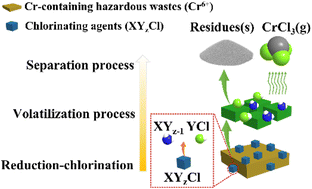Robust route to efficient extraction of Cr from different Cr-containing hazardous wastes by capitalizing on a reduction–chlorination–volatility technique†
Abstract
The recovery of chromium (Cr) is of key importance to recycling Cr-containing hazardous wastes and reducing its environmental pollution. However, the strong affinity between Cr and its host crystals restricts the Cr extraction rate. Here we report a viable strategy to efficiently extract Cr from four different Cr-containing wastes (chromium ore processing residue, tannery sludge, electroplating sludge and stainless steel slag) by a reduction–chlorination–volatility route. The amount of Cr of different valence states is quantified using X-ray absorption near edge structure (XANES) measurements. During the Cr recovery process, the phase conversion of host crystals weakens the binding force between Cr and its hosts. Thus, Cr is released and recovered in the form of CrCl3 and chromite/spinel. Under optimal conditions, the recovery of Cr could reach almost 100%. Notably, this Cr extraction technique is applicable to the industrial large-scale chromium recovery of COPR at the ton level, achieving a Cr extraction rate of 98.39%. Thermodynamic and kinetic investigations are performed to explore the Cr recovery process. The volatilization process of CrCl3 can be described by the 3D Jander equation f(α) = 3/2(1 − α)2/3 [1 − (1 − α)1/3]−1. This work opens a new insight into understanding the industrial regeneration of Cr from Cr-containing solid wastes.



 Please wait while we load your content...
Please wait while we load your content...